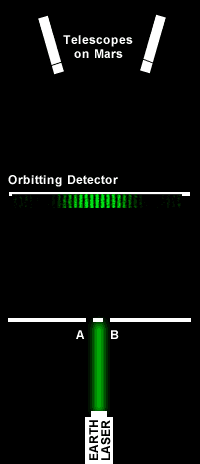|
||
Let There Be Light, Part II...Continued from Part I So how does a photon know when somebody is looking at it? First, let's ask why someone might think that it does. Remember from before that light will produce a different pattern depending on whether or not both slits were open. The obvious answer might be that light, even a single photon, is a wave spread out in space as it passes through the slits, hence the interference pattern. Later on, through some hypothetical mechanism, the wave collapses into a single point on the screen. Or possibly a photon really is a particle, and the interference pattern is caused by as of yet undetectable pseudo-photons passing through the other slit when it's open. Both of these theories have some hand waving, but they would explain
the seemingly paradoxical behavior we've witnessed. Unfortunately, it's
a bit more complicated than that. Consider this experiment (illustrated
to the right): Here on Earth, we fire a steady stream of photons through a double slit toward a pair of powerful telescopes on Mars, pointing back at the slits. What do the Martians see? Well, because of the setup, the Martians can tell which slit any particular photon went through (actually any photon that makes it into the telescope- in reality many wouldn't). And Quantum Mechanics tells us that no wave pattern will be detected for any photon that can be definitively linked to a particular slit. Now halfway between the Earth and Mars is an orbiting detector, just like in the first experiment, that will detect a wave interference pattern. What does it see? When it's in place, it sees the wave pattern. Of course, when the orbiter is in place, no photons make it to Mars- the orbiter is in the way. Imagine what would happen if a photon were fired through the slits at noon one day. A few seconds later the pilot of the orbiting detector can either move into the photon's path, or move out of the way (assume that the pilot has synchronized his watch with the folks at home and knows when the experiment will occur). In this scenario, if the orbiting detector is in the way, a wave pattern is detected, but we don't know which slit the photon went through. If the photon makes it to Mars, there is no wave pattern, but we know which slit the photon went through. Somehow, the decision as to which experiment to perform affected the outcome- despite the decision being made after the photon supposedly went through the slits! Even more strange, the "information" as to which experiment was performed seems to have traveled faster than the speed of light. This is a modified description of an experiment proposed by John Wheeler. While this exact experiment has obviously never been performed, similar ones have demonstrated clearly that a) the choice of experiments effects whether a particle was detected at a distinct location or whether a particle was spread out like a wave and b) this effect seems to propagates faster than the speed of light. Almost as if the particle knew when and where someone would be looking at it before it happened. Now if this seems weird (and it should!) wave-particle duality doesn't just apply to light, it applies to massed particles as well. It has been definitely detected in electrons and other microscopic particles, and all evidence indicates that it exists to some degree for any sized object, although the effect would be too small to measure for objects visible to the naked eye. I feel at this point that I've given an admittedly inadequate overview of the fundamental problem of wave-particle duality displayed in the dual-slit experiment. Before presenting the conclusion, I'd like to give visitors some other sources to investigate further:
Next time, we wrap up this topic by discussing the various interpretations of this "paradox" and their relative merits. |
||
|
Copyright © 1996-2025 Wx3, All Rights Reserved.
|






